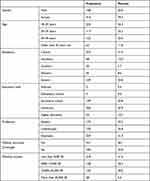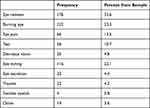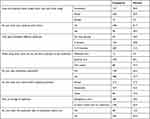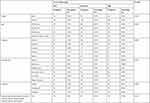Back to Journals » Clinical Ophthalmology » Volume 16
Knowledge, Attitudes, and Practices Toward Self-Medicating Eye Symptoms in Saudi Arabia
Authors Alessa DI, AlHuthail RR, Al Mahfud SA , Alshngeetee AS , Alruwaili SA , Khalaf AM, Almutlq MM
Received 15 December 2021
Accepted for publication 25 February 2022
Published 10 March 2022 Volume 2022:16 Pages 723—731
DOI https://doi.org/10.2147/OPTH.S352964
Checked for plagiarism Yes
Review by Single anonymous peer review
Peer reviewer comments 2
Editor who approved publication: Dr Scott Fraser
Dalal Ibrahim Alessa,1 Reem Rashed AlHuthail,1 Shahd Abdullah Al Mahfud,2 Ayshah Sayed Alshngeetee,2 Shahad A Alruwaili,2 Ahmad Mamoun Khalaf,2 Malak Mohammed Almutlq2
1Department of Ophthalmology, College of Medicine, Imam Mohammad Ibn Saud Islamic University (IMSIU), Riyadh, Saudi Arabia; 2College of Medicine, Imam Mohammad Ibn Saud Islamic University (IMSIU), Riyadh, Saudi Arabia
Correspondence: Shahd Abdullah Al Mahfud, Department of Ophthalmology, College of Medicine, Imam Mohammad Ibn Saud Islamic University (IMSIU), Riyadh, Saudi Arabia, Tel +966 561280230, Email [email protected]
Purpose: Self-medication is the selection and use of drugs by individuals to treat self-diagnosed diseases or symptoms. While some patients regard self-medicating as harmless, it is far from being a safe practice. The aim of this study was to evaluate the knowledge, attitudes, and practices toward self-medicating eye symptoms in Saudi Arabia.
Patients and Methods: A cross-sectional study was conducted through an online questionnaire on a study population that consisted of Saudi nationals aged 18 and older who were using or had previously used ophthalmic medications.
Results: Among the 524 responses obtained, 79.4% were female, and more than half were less than 40 years old. Participants admitting to practicing ophthalmic self-medication measured 62.4%. The most commonly self-prescribed ophthalmic medications were artificial tears (n=276), followed by antiallergic (n=57) and antibiotic medications (n=33). Many participants reported that the reason for self-treatment was for repeated and simple symptoms that did not require professional care. While approximately 51% showed high levels of knowledge about ophthalmic medications, no significant relationship was seen with their choice to self-medicate (P=0.153).
Conclusion: Despite detecting a high level of knowledge and acceptable practices and attitudes among participants, a high incidence of self-medication was observed. This effect was mostly attributed to long hospital waiting times and patient self-diagnosis. Increasing the number of healthcare units and properly educating patients on ophthalmic medications may help decrease the incidence of self-medication.
Keywords: eye drops, KAP, Saudi Arabia, self-medication, traditional eye medicine
Introduction
Self-medication is the selection and use of drugs by individuals to treat self-diagnosed diseases or symptoms. This includes the use of herbs, prescription drugs without a valid prescription, and leftover medications that were used by other patients.1 While some patients regard self-medication as harmless, it is far from being a safe practice. Potential risks of self-administration of ophthalmic medications include loss of vision, dangerous drug interactions, incorrect choice of treatment, inappropriate administration, and drug abuse.2 The practice of self-medication is common in both industrialized and developing countries with a prevalence ranging from 25.6% to 73.6%.3,4 It is also positively linked to the perceived quality of the country’s healthcare system.5 Despite the recent enforcement of a law that was passed by the Ministry of Health in 1978 which prohibits selling prescription drugs without a medical prescription in Saudi Arabia, misuse of these medications is still prevalent.6 A study conducted in the Riyadh region among 1354 participants revealed a high prevalence (37.2%) of self-medication.7 Another study reported the incidence of self-medicating with traditional eye medicine (TEM) in Taif city to be 35%.8 This study aims to explore the knowledge, attitudes, and practices (KAP) toward the exercise of self-medication for eye symptoms in Saudi Arabia.
Materials and Methods
Study Population
The study population consisted of Saudi nationals aged 18 and older who were using or had previously used ophthalmic medications. Non-Saudis, healthcare providers, underage participants, and individuals who had never used any form of ophthalmic medication were excluded from the study.
Data Collection
Data were anonymously collected using a simple convenient sampling approach. The authors distributed the survey in public chat groups and accounts on Telegram, WhatsApp and Twitter, with followers from different regions in Saudi Arabia. The sample size was calculated using OpenEpi based on a previous study and was estimated to be 380.7 The questionnaire was validated through face-validity based on study objectives and was then tested-retested for a reliability check. The survey was initially written in English but was later translated to Arabic and tested for consistency by authors who have had training on medical translation and are native speakers of Arabic.
The self-developed questionnaire was composed of five parts: The first part contained seven items assessing demographics and nine items measuring knowledge. The second and the third parts were about self-medication, drug installation, and storage practices. The fourth part was about knowledge toward ophthalmic medications. The fifth part was about attitudes toward self-medication.
To measure the participants’ knowledge, each correct question answered in the knowledge section was awarded one point. As this category contained nine questions, the final score of each participant ranged from zero to nine points. Sub-scales were calculated where scores higher than five were reported as a high level of knowledge, 3–5 points as a moderate level of knowledge, and two or less as a low or absent level of knowledge. Participants were informed about the purpose of the survey.
Ethical Approval
This study was approved by the Institutional Review Board (IRB) committee of the College of Medicine at Imam Mohammed bin Saud Islamic University.
Statistical Analysis
Data analysis was performed using SPSS software (Statistical Package for the Social Sciences, version 22, SPSS Inc. Chicago, IL, USA). Descriptive statistics were calculated for all variables, including the prevalence, mean, standard deviation, and shape of the distribution (skewness and kurtosis). A p-value <0.05 was considered statistically significant at a confidence interval of 95%.
Results
A total of 524 participants responded to the questionnaire. Most respondents (79.4%) were female. Many participants (64.7%) were less than 40 years old and only 11.8% were older than 50 (Table 1).
 |
Table 1 Demographic Factors |
Of the total respondents, 326 (62.4%) admitted to using a type of ophthalmic medication such as eye drops, eye ointment, or TEM without a prescription. The most frequently used treatments were artificial tears (n=276), followed by antiallergic (n=57) and antibiotic (n=33) eye drops (Figure 1).
 |
Figure 1 Type of ophthalmic self-medication used by the participants. |
The reported traditional ophthalmic medications that were used included “Zamzam” holy water (n=69), breast milk (n=40), honey (n=33), tea (n=30), homemade saline (n=23), lemon (n=4), cautery (n=1), and kohl (n=1).
The most common symptoms that prompted the practice of self-treatment were eye redness (33.6%), burning sensation in the eye (23.3%), eye itching (22.1%), eye pain (12.6%), and tearing (10.7%) (Table 2).
 |
Table 2 Symptoms Lead the Participant to Self-Medication |
Pharmacists were the most common source for drug recommendation (43.4%), followed by family members or friends (41.2%), and social media (5.8%). A majority of participants who practiced self-medication (84.9%) reported that their symptoms became better, while 14.4% reported no change in symptoms, and 0.7% became worse after self-medicating. The most common reason for self-medication was having similar symptoms in the past (36.6%), and 26.8% thought that their cases were simple and did not warrant a visit to the ophthalmologist (Table 3).
 |
Table 3 Reasons for Self-Medication Among Participants |
Most participants (64.9%) reported that they had never let the eye drop nozzle touch their eyes when applying the medication. Some participants admitted to sharing their eye drop medication with other individuals (18.3%). Many participants (18.9%) did not space between their eye drop medications when using them together, while 15.3% thought it would not matter if they started applying eye drop medication or eye ointment when prescribed together. Most participants (73.7%) stated that they read the medication pamphlet, and the vast majority (87%) read the expiration date of the medication before using it. Moreover, 41% of participants would always wash their hands before using eye drops. Finally, 54.6% store ophthalmic medications in the refrigerator while 45.4% store them in warm rooms (Table 4).
 |
Table 4 Eyedrop Installation and Storage Practices |
According to many participants (87%), most of the information conveyed to them by healthcare professionals was about the medication dose and duration of use. However, some participants (40%) reported that they were taught how to apply the medication, and few reported being provided information about storage conditions (7%) and side effects (12.5%).
Nearly 51% of the sampled respondents had a high level of knowledge about eye medications, while 41% had a moderate level of knowledge, and 10.9% had low or absent levels of knowledge. Level of knowledge was determined by knowing right answers regarding correct storage and usage of eye medication and seeking information from the appropriate sources. There was no significant difference between males and females in their level of knowledge (P=0.556). Although older participants seem to have a higher level of knowledge than younger participants, no significant correlation was seen (P=0.632). Area of residency and education level did not seem to affect the level of knowledge. In contrast, participants’ professions had a significant influence on the level of knowledge. Interestingly, unemployed participants had a higher level of knowledge compared to other professions. Finally, when the participants were asked about their attitude toward self-medication, 84.5% thought that it was dangerous and ineffective, and 25.4% reported that they would use these medications again without counseling a healthcare provider (Table 5).
 |
Table 5 Association Between Demographic Factors and Level of Knowledge |
Discussion
This study will aid in recognizing the most commonly used ophthalmic medications and usage patterns. Addressing those medications and their side effects and correct uses is very important in terms of educating the population. Individuals may find the urge to self-medicate when they experience eye symptoms before or even without seeking professional medical care. The medications used may include pharmaceutical eye drops, eye ointments, or TEM. However, the reasons behind the practice of self-medication are not fully understood and vary among different populations.
Medical policies in Saudi Arabia restrict dispensing some drugs without a prescription.7 The prevalence of self-medication with ophthalmic medications or TEM is 62.4% in our study, which is higher than the reported prevalence in Argentina (25.6%) and Brazil (40.5%). The prevalence is, however, lower than what was reported in Nigeria (73.6%).3 Additionally, the prevalence differs within Saudi Arabia where it was reported to be 54.1% in the Riyadh region, and 35% in Taif.7,8 These variations may be due to the utilization of different study designs and target populations.
In our study, lubricant, antiallergic, and antibiotic eye drops were the most commonly self-medicated eye treatments. In contrast, other studies revealed that antibiotics were the most common medication used while antiallergic and steroid eye medications ranked second.3,9,10 These differences may be attributed to the high prevalence of allergy and dry eye in the Saudi community as well as the restrictions implemented on antibiotic dispensing since 2018.7,11,12
The most common TEM used in our study was “Zamzam” holy water. This is similar to another study done in Saudi Arabia, where the most commonly used TEM was spiritual, including “Zamzam” holy water.13 The efficacy and safety of “Zamzam” water in treating eye diseases have not been established.
In this study, the most common symptoms that triggered self-treatment were eye redness and itching. This finding is concordant with other studies done in India and Ethiopia.4,14 The practice of self-medication might delay the treatment of more severe conditions like infections that might present with similar symptoms.
A proper technique involving multiple steps is used to administer eyedrop medications with maximum effectiveness without contaminating the bottle. However, there is no specific way to apply them optimally. In our study, many participants showed acceptable eye drop instillation practices, defined as practices not expected to cause any kind of harm to the eyes. Additionally, 58.9% of participants sometimes or never washed their hands before putting the eyedrop and 35.2% reported that the bottle nozzle sometimes or always touched the eye while applying the eye drop treatment. Furthermore, 18.3% of participants reported sharing their eye drop medication with others. These practices might lead to contamination of the eye drop and subsequent eye infection.15 19% of participants instilled their drops back-to-back, and nearly 18% might have applied an eye ointment first before the eye drop. Patients should be informed about the washout effect that happens when eye drops are instilled back-to-back: The conjunctival cul-de-sac capacity is 30 µL and one eye drop ranges from 29 to 65 µL, and any excess volume will be washed out.16
Eye drop preparations have different storage requirements. If stored inappropriately in hot, wet, or brightly illuminated places, these medications might lose their effectiveness because of changes in their chemical and physical properties. Most ophthalmic preparations are stored in a cool dry place between 2–8°C. Some drugs can be irreversibly degraded when exposed even briefly to temperatures between 25°- 30°C. These temperatures could easily occur in the bedrooms in countries with hot climates like Saudi Arabia. Our results showed that 45.4% of participants stored their medication in warm rooms; this finding is similar to a study done by Mohindroo et al (35%) and Alfawzan et al (43%). Although many rooms are equipped with air conditioning; medications can still be affected by hot weather.17,18 In our population, most of the participants were young with no comorbidities. The quality of eye drop instillation and storage techniques may be lower in older patients, patients with severe visual field defects, poorly educated patients, and patients with comorbidities such as arthritis.19
Pharmacists have a significant influence on which medication consumers use for their complaints.20 In our study, they represented 43.4% of the source of recommendation for self-medication, which is similar to other studies9. Moreover, most participants reported that pharmacists and ophthalmologists were more interested in discussing medication dose and duration rather than the method of application, storage guidelines, and side effects. This observation is comparable to a study done by Alfawzan et al.18 Healthcare providers are required to give proper instructions on drug dose, duration, as well as eye drop instillation techniques as improper drug application may lead to contamination and noncompliance. Incorrect storage may also lead to a change in the chemical properties of the medication, consequently resulting in a loss of efficacy. Lack of knowledge regarding the side effects of medications may lead to improper use and self-medication.16,21,22
In our study and in a study conducted in Nigeria, participants showed an attitude advocating against self-medication, yet they still seem to self-medicate despite it being dangerous and sometimes ineffective. Self-medication with ophthalmic medications can lead to corneal ulceration, endophthalmitis, evisceration, exenteration, and even blindness.23,24 This attitude toward self-medication could be due to various reasons. In our study, participants mainly sought self-medication because they experienced similar symptoms before. Others thought that their cases were simple and not worth the long waiting time that accompanies a visit to the ophthalmologist. In contrast, studies conducted in Ethiopia and India revealed that travel distance was the primary reason for self-medication.4,14
No correlation was seen between demographic factors and level of knowledge, except with profession; participants’ profession had a significant influence on the level of knowledge. Furthermore, it was found that the practice of self-medication was not affected by the individual’s level of knowledge. This finding is comparable to the results of a study done in Peru.25 However, it seems that participants with a low level of knowledge were more interested in self-medicating. This association is concordant with the results of another article in Ethiopia.4
This study was conducted by using an online-based survey that collected the most recent responses amongst the general population in Saudi Arabia, however, study only included people that would respond to an on-line chat-based solicitation population. On the other hand, our study limitations include recall and response bias where the respondents may have answered differently to “look good” in the survey, even if it is anonymous. Another limitation of the present study is that the majority of respondents were females, and the small sample size may not be sufficient to generalize the findings across the population.
In conclusion, we found a high level of knowledge among the participants along with acceptable practices and attitudes. There is a high incidence of self-medicating with ophthalmic medications, which can be attributed to long waiting times at the hospital and self-diagnosis. The government of Saudi Arabia implemented laws that prohibit dispensing most medications without a valid prescription from a licensed practitioner. Increasing the number of healthcare units and proper education of patients regarding the harmful effects of some herbal and none prescribed medication may decrease the incidence of self-medication. Despite these findings, further studies are needed to better understand and evaluate the knowledge, attitude, and practice toward eye drops and self-medication in Saudi Arabia.
Funding
This research received no grant or funding from any institution.
Disclosure
Authors declare the absence of any commercial or financial relationships or any other form of interest.
References
1. Loyola Filho AID, Lima-Costa MF, Uchôa E. Bambuí project: a qualitative approach to self-medication. Cad Saude Publica. 2004;20:1661–1669. doi:10.1590/S0102-311X2004000600025
2. Ruiz ME. Risks of self-medication practices. Curr Drug Saf. 2010;5(4):315–323. doi:10.2174/157488610792245966
3. Ajayi IA, Omotoye OJ, Ajite KO, Fadamiro CO, Ajayi EA. Self medication practices among patients seen in A suburban tertiary eye care centre in Nigeria. Asian J Med Sci. 2014;5(2):85–90. doi:10.3126/ajms.v5i2.8452
4. Adimassu NF, Woldetsadik ZG, Alemu HW. Proportion of ophthalmic self-medication and associated factors among adult ophthalmic patients attending Borumeda Hospital, Dessie, Northeast Ethiopia. J Ophthalmol. 2020;2020:1–7. doi:10.1155/2020/6932686
5. Gore PR, Madhavan S. Consumers’ preference and willingness to pay for pharmacist counselling for non-prescription medicines. J Clin Pharm Ther. 1994;19(1):17–25. doi:10.1111/j.1365-2710.1994.tb00803.x
6. Bawazir SA. Prescribing pattern at community pharmacies in Saudi Arabia. Int Pharm J. 1992;6:222.
7. Alburayk KB, Alqahtani BS, Alsarhani WK. Ophthalmology self-medication practices: a questionnaire-based study. Ophthalmic Epidemiol. 2021;28(5):453–457.
8. Bifari I, Alkhaldi AA, Almalki RK, et al. Use of traditional eye medicine and self-medication among population of Taif City, Saudi Arabia: a cross sectional study. Middle East J Fam Med. 2020;18(1):43–48.
9. Marquez G, Piñeros-Heilbron H, Sanchez VM, et al. Eye drop self-medication: comparative questionnaire-based study of two Latin American cities. J Clin Exp Ophthalmol. 2014;05(02). doi:10.4172/2155-9570.1000330
10. Carvalho RS, Kara-José N, Temporini ER, Kara-Junior N, Noma-Campos R. Self-medication: initial treatments used by patients seen in an ophthalmologic emergency room. Clinics. 2009;64:735–741. doi:10.1590/S1807-59322009000800005
11. Bukhari A, Ajlan R, Alsaggaf H. Prevalence of dry eye in the normal population in Jeddah, Saudi Arabia. Orbit. 2009;28(6):392–397. doi:10.3109/01676830903074095
12. Alqurashi KA, Bamahfouz AY, Almasoudi BM. Prevalence and causative agents of allergic conjunctivitis and its determinants in adult citizens of Western Saudi Arabia: a survey. Oman J Ophthalmol. 2020;13(1):29. doi:10.4103/ojo.OJO_31_2019
13. Alrowais NA, Alyousefi NA. The prevalence extent of complementary and alternative medicine (CAM) use among Saudis. Saudi Pharm J. 2017;25(3):306–318. doi:10.1016/j.jsps.2016.09.009
14. Gupta R, Malhotra P. Self-medication in ophthalmology-a northern Indian tertiary hospital experience. Int J Basic Clin Pharmacol. 2016;5(6). doi:10.18203/2319-2003.ijbcp20160079
15. Geyer O, Bottone EJ, Podos SM, Schumer RA, Asbell PA. Microbial contamination of medications used to treat glaucoma. Br J Ophthalmol. 1995;79(4):376–379. doi:10.1136/bjo.79.4.376
16. Costa AXD, Gama RMD, Kitadai SPS, Andrade EPD, Ferro GBR, Gomes JÁP. Drop volume of artificial tear solutions: pharmacoeconomic study. Rev Bras Oftalmol. 2015;74:339–344. doi:10.5935/0034-7280.20150071
17. Curti C, Lamy E, Primas N, et al. Stability studies of five anti-infectious eye drops under exhaustive storage conditions. Die Pharm Int J Pharm Sci. 2017;72(12):741–746.
18. Alfawzan A, Al Ahmed A, Almuhanna S, et al. A cross-sectional study of the actual use of eye drops in a Saudi community. Trop J Pharm Res. 2018;17(4):709–713. doi:10.4314/tjpr.v17i4.21
19. Davis SA, Sleath B, Carpenter DM, Blalock SJ, Muir KW, Budenz DL. Drop instillation and glaucoma. Curr Opin Ophthalmol. 2018;29(2):171. doi:10.1097/ICU.0000000000000451
20. Kamat VR, Nichter M. Pharmacies, self-medication and pharmaceutical marketing in Bombay, India. Soc Sci Med. 1998;47(6):779–794. doi:10.1016/S0277-9536(98)00134-8
21. Danny H, Jokl K, Wormser GP, Nichols NS, Montecalvo MA, Karmen CL. Bacterial contamination of ophthalmic solutions used in an extended care facility. Br J Ophthalmol. 2007;91(10):1308–1310. doi:10.1136/bjo.2007.115618
22. (Mandal) DRB. Knowledge, attitude and practice regarding ocular topical steroid among patients visiting tertiary care hospital at Rampurhat, West Bengal. J Med Sci Clin Res. 2020;08(01):302–307. doi:10.18535/jmscr/v8i1.43
23. Ayanwale MB, Okafor IP, Odukoya OO. Self-medication among rural residents in Lagos, Nigeria. J Med Trop. 2017;19(1):65. doi:10.4103/jomt.jomt_51_16
24. Jaya Y, Masanganise R. The prevalence, types and effects of traditional eye medicine use among newly presenting patients at Sekuru Kaguvi Hospital Eye Unit in Harare, Zimbabwe. Cent Afr J Med. 2014;60(2):36–44.
25. Núñez M, Tresierra-Ayala M, Gil-Olivares F. Antibiotic self-medication in University students from Trujillo, Peru. Med Univ. 2016;18(73):205–209.
 © 2022 The Author(s). This work is published and licensed by Dove Medical Press Limited. The
full terms of this license are available at https://www.dovepress.com/terms.php
and incorporate the Creative Commons Attribution
- Non Commercial (unported, v3.0) License.
By accessing the work you hereby accept the Terms. Non-commercial uses of the work are permitted
without any further permission from Dove Medical Press Limited, provided the work is properly
attributed. For permission for commercial use of this work, please see paragraphs 4.2 and 5 of our Terms.
© 2022 The Author(s). This work is published and licensed by Dove Medical Press Limited. The
full terms of this license are available at https://www.dovepress.com/terms.php
and incorporate the Creative Commons Attribution
- Non Commercial (unported, v3.0) License.
By accessing the work you hereby accept the Terms. Non-commercial uses of the work are permitted
without any further permission from Dove Medical Press Limited, provided the work is properly
attributed. For permission for commercial use of this work, please see paragraphs 4.2 and 5 of our Terms.
